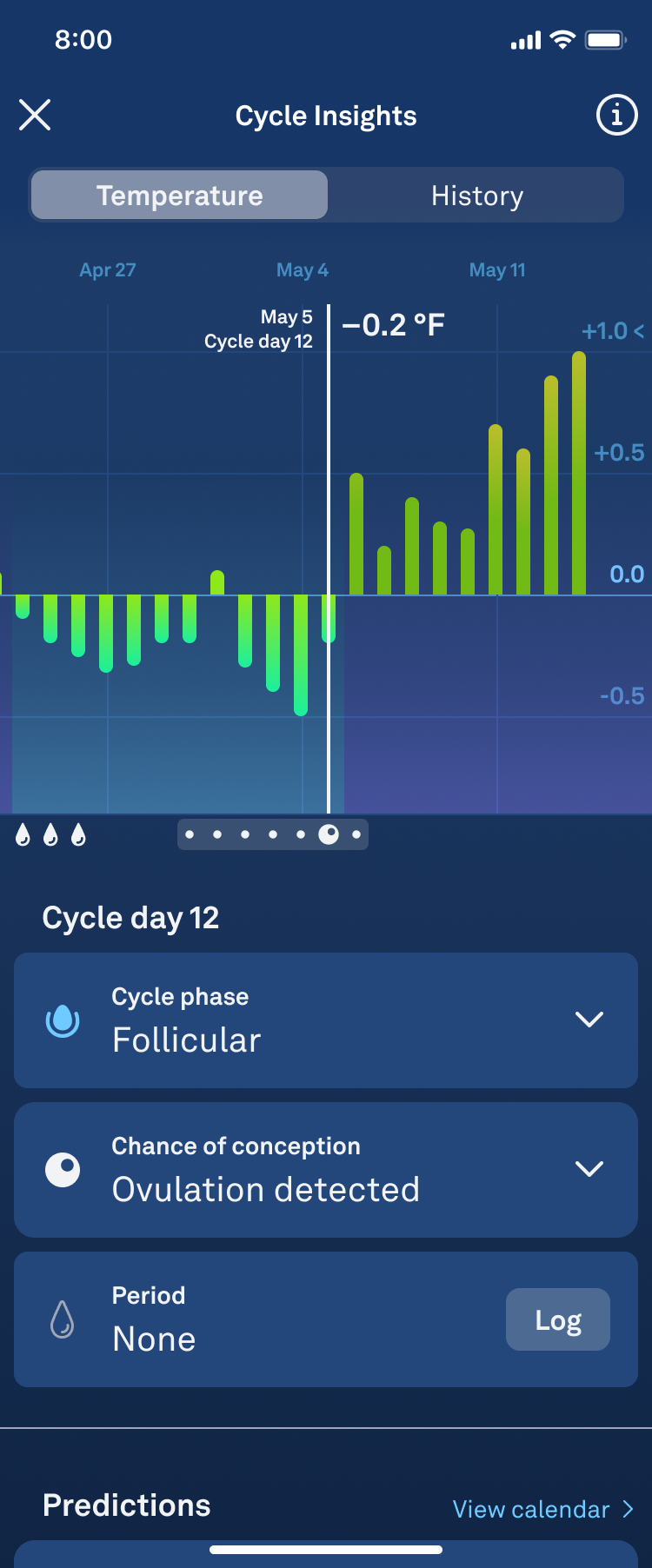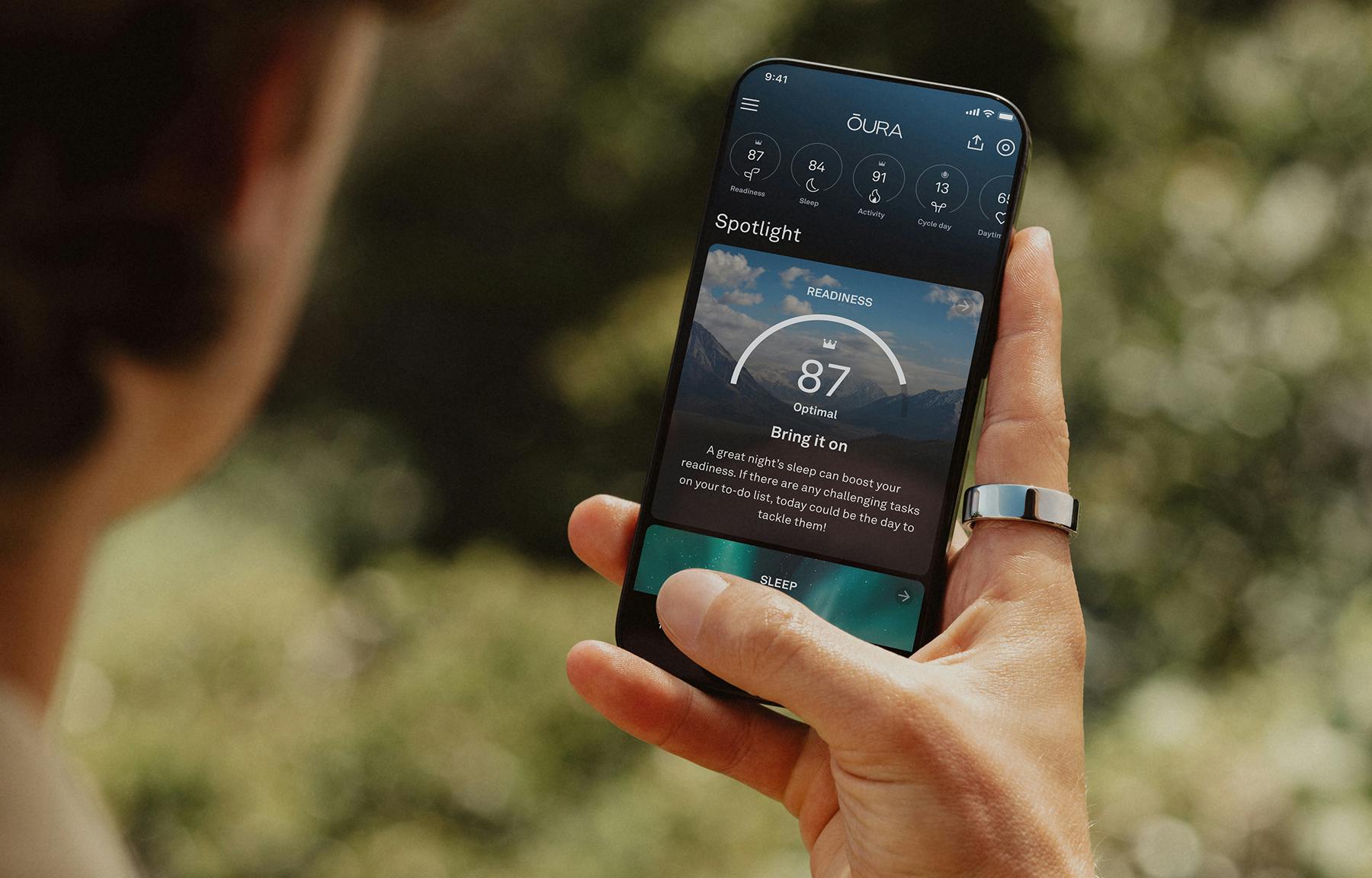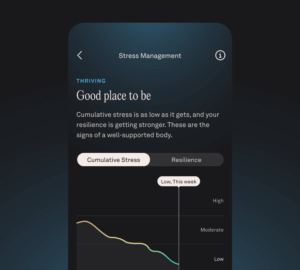Fertile Window, a new addition to the Cycle Insights suite of women’s health features, provides members with information about which days of the month they’re most likely to conceive.
As with all new Oura features, Fertile Window was carefully designed by a team of women’s health experts, scientists, and designers who worked for more than four years to ensure it is as accurate as it is intuitive. Keep reading to learn more about the development and scientific validation of this feature.
| Note: Oura’s Fertile Window feature is not intended to be used for contraception, and doing so may lead to unintended pregnancy. For a hormone-free birth control option, try Natural Cycles, powered by Oura. |
Fertile Window: The Latest Addition to Cycle Insights
 “At Oura, our continued vision is to create experiences for women that empower them to become the experts of their own bodies,” says Neta Gotlieb, PhD, Women’s Health Senior Product Manager at Oura. “We want Oura to be a trusted health companion across all women’s reproductive chapters.” One of these chapters is the journey to becoming a mother, which begins with trying to conceive.
“At Oura, our continued vision is to create experiences for women that empower them to become the experts of their own bodies,” says Neta Gotlieb, PhD, Women’s Health Senior Product Manager at Oura. “We want Oura to be a trusted health companion across all women’s reproductive chapters.” One of these chapters is the journey to becoming a mother, which begins with trying to conceive.
However, conception is not always a simple process. “Unlike what we’re taught in sex education at school, trying to conceive can be stressful for many couples, and it often takes time,” says Dr. Gotlieb. Many women lack access to the tools and body literacy needed to understand when they are most fertile.
Among the existing methods to detect fertile days, there are drawbacks, Dr. Gotlieb notes: “Ovulation predictor kits (LH tests) only capture the tail end of the fertile window, while temperature tracking, ultrasound imaging, and progesterone tests only detect ovulation after it happens, missing the fertile days entirely.”
Predicting the fertile window (which Oura’s Fertile Window feature does) is the key to success, but it’s also the most complicated part. The feature took the Oura women’s health team four years to develop from the beginning stages to the final product.
READ MORE: Meet Oura’s Cycle Insights Feature
Developing the Fertile Window Algorithm
Work on Oura’s Fertile Window algorithm began in 2020.
“We prioritized designing an algorithm that works for everyone, including individuals with irregular cycles, as they often encounter the biggest hurdles with existing solutions,” says Xi Zhang, VP, Health Sensing at Oura. “Developing algorithms for irregular cycles is more challenging, but it’s also where the impact can be most significant.”
 The algorithm is powered by artificial intelligence (AI)—specifically, a deep learning model trained and validated on millions of nights of Oura Ring data. These AI models learn each member’s unique physiological patterns, leveraging skin temperature trends, cardiovascular health data, respiratory data, cycle regularity, and tag data to ensure accuracy, even with imperfect wear.
The algorithm is powered by artificial intelligence (AI)—specifically, a deep learning model trained and validated on millions of nights of Oura Ring data. These AI models learn each member’s unique physiological patterns, leveraging skin temperature trends, cardiovascular health data, respiratory data, cycle regularity, and tag data to ensure accuracy, even with imperfect wear.
The team put enormous care and effort into making the model personalized. By capturing these personal nuances, the models can make highly individualized predictions tailored precisely to each member’s menstrual cycle.
Collecting enough data is only the first step in algorithm building, however. The algorithm must dynamically adapt to member inputs, even retroactively, to update historical cycles, which adds a unique challenge for validation and implementation.
The team overcame these challenges by developing an algorithm that not only adapts to each member’s unique physiological patterns, but also dynamically updates historical cycles as more data is collected, ensuring ongoing precision and relevance.
READ MORE: Oura’s Commitment to Reproductive Health Data Privacy
Collecting “Better-Than-Gold-Standard” Data
“Behind every great algorithm at Oura is many hours of human data collection,” says Jillian Peacock, Technical Project Manager and Lead Research Manager for Women’s Health at Oura. “We decided to aim higher and collect better-than-gold-standard reference data, with the goal to validate the performance of Fertile Window.”
This is where Oura’s clinical research scientists and research operation teams play an important part. “In collaboration with the UCSF Center for Reproductive Health and Oura medical advisor Dr. Eleni Jaswa, we developed a protocol that would not only validate our algorithms with higher accuracy than our reference data, but would also raise the bar for the entire industry,” says Peacock.
In the study, participants wore Oura Ring to track their menstrual cycles and completed a daily survey. From cycle day 10 through to ovulation, they also used daily at-home ovulation predictor kits to measure their LH (luteinizing hormone) levels and visited a clinic daily for transvaginal ultrasounds to monitor ovarian follicle development and ovulation status.
“We collected a huge amount of data during the two years of the study,” Peacock says. “We monitored hundreds of cycles with hundreds of confirmed ovulations from more than 100 women with regular cycles.”
Validating the Fertile Window Algorithm Performance
Unlike previous models and most competitors—which rely solely on temperature data for menstrual cycle predictions—the new Fertile Window algorithm incorporates a wide range of data, including cardiovascular and respiratory metrics, as well as tag data. The more data, the more accurate the algorithm.
In addition to evaluating millions of nights’ worth of data, two clinical trials plus in-app beta testing were conducted to validate the accuracy.
The most recent study, published in The Journal of Medical Internet Research (JMIR), found that Oura’s ovulation detection algorithm outperformed the traditional calendar tracking method. The Fertile Window algorithm detected 96.4% of ovulations with an average error of ±1.26 days, making it significantly more precise (even in groups with irregular cycles) than the calendar method, which exhibited an average error of ±3.44 days.
READ MORE: Oura’s Ovulation Detection Algorithm Outperforms Calendar Tracking Method in New Validation Study
Advancing Accuracy in Period Prediction
This new algorithm doesn’t only power Fertile Window; it also enhances the accuracy of all Cycle Insights features. Oura’s period prediction feature in particular saw great improvements for groups that are typically challenging to forecast, such as those in perimenopause and with irregular cycles.
Now, period predictions are:
- More than twice as accurate for all members.
- Nearly three times as accurate for members in perimenopause.
- Twice as accurate for members with irregular cycles.
READ MORE: How Oura Can Help You Manage Perimenopause
What’s Next
“As a human-first company, we are continuing our clinical research with a second UCSF study, including women with irregular cycles and PCOS, with results expected in 2025,” Peacock says. “This is a first-of-its-kind study from a large population that is tremendously under-served and has no credible solutions available in the market.”
Oura’s women’s health team remains deeply committed to continuing research and development of powerful features like Fertile Window – so you can stay informed, empowered, and supported through every phase of your health journey.
“In addition, our commitment to innovation is deeply rooted in science; we’re investing heavily in research, working with leading institutions like UCSF, UC Berkeley, and Stanford to advance our understanding of women’s health,” Dr. Gotlieb adds. “The positive feedback we receive from our members fuels our passion and guides our development, ensuring we’re meeting their needs and making a real difference in their lives.”
RELATED: Your Guide to Hormonal and Non-Hormonal Birth Control Methods
About the Oura Experts
Neta Gotlieb, PhD, is a Senior Product Manager and Clinical Research Scientist who’s driven by a desire to support women with intuitive, useful features and easy-to-understand data and insights. At Oura, Dr. Gotlieb has led the teams that developed innovative women’s health features, such as Cycle Insights and Pregnancy Insights. Dr. Gotlieb earned a Master’s Degree in Biological Psychology from Tel Aviv University and a PhD in Reproductive Neuroendocrinology from University of California Berkeley, where she focused on the neural regulation of menstrual cycles, pregnancy, and birth. She has also received the Women in Tech Global Technology Leadership Award. A mother of two daughters, Dr. Gotlieb is the author of the children’s book, Every Body’s Brain.
Jillian Peacock is a Research Project Manager at Oura focusing on women’s health, with over 7 years of research experience ranging from athletic performance to healthy aging. Outside of work, you can find her running, enjoying the outdoors, and spending time with her family.
Xi Zhang, PhD, is the Head of Health Sensing at Oura. He supports a global team of scientists to research and develop algorithms for multiple health applications. Dr. Zhang received his PhD from the University of Michigan and built the world’s first non-invasive thrombolysis robot. He worked at Fitbit first and then Apple after graduate school. He is also serving on the editorial board of Ultrasound in Medicine and Biology journal focusing on the ML/AI applications.










